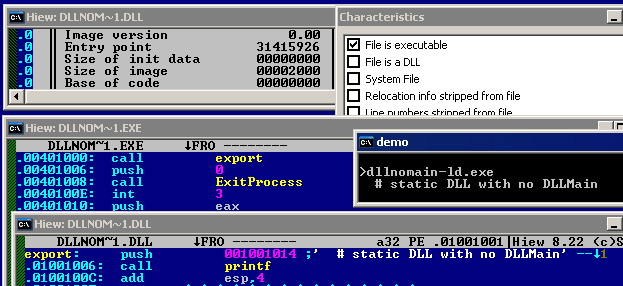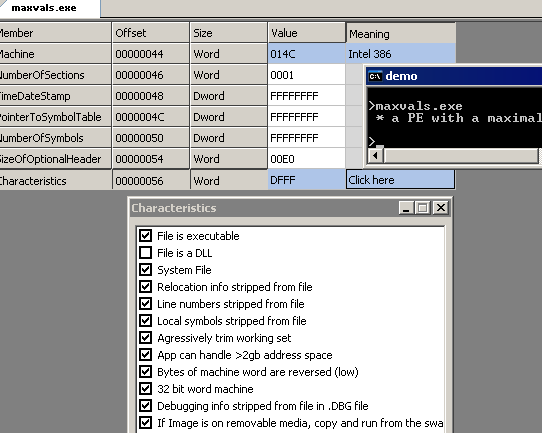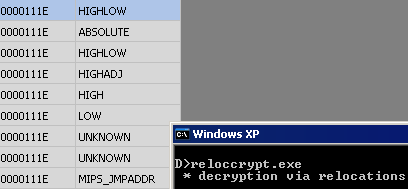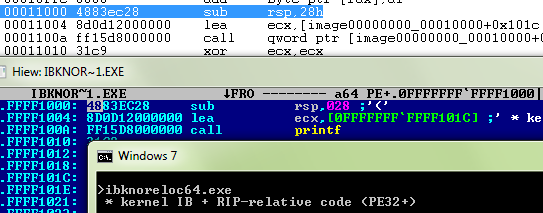<< index Android/Java/x86/... opcodes tables PDF tricks Portable Executable x86 oddities PEThis page deals with the PE format, or more specifically, x86/x64 Windows (from XP to W7) binaries (ie, not other OSes or systems, not OBJ format, etc...) if you're not familiar with this format, check PE 101 - a Windows executable walkthrough. It deals with the reality of the loader, not the theory of the format itself, as specified in Microsoft PE and COFF Specification. Many malwares or packers actually run without a problem, while they theoretically shouldn't. All proof of concepts are included with source: - They're all working and clean.
- They're all generated in asssembly, by hand, from scratch, so no superfluous information is included (they might be wrongly detected as suspicious for that).
- links
required elementsa standard (high aligments, sections, imports) PE such as normal can be defined with only the following structure elements: at IMAGE_DOS_HEADER.e_magic, db 'MZ'
at IMAGE_DOS_HEADER.e_lfanew, dd NT_Signature - IMAGEBASE
...
at IMAGE_NT_HEADERS.Signature, db 'PE', 0, 0
...
at IMAGE_FILE_HEADER.Machine, dw IMAGE_FILE_MACHINE_I386
at IMAGE_FILE_HEADER.NumberOfSections, dw NUMBEROFSECTIONS
at IMAGE_FILE_HEADER.SizeOfOptionalHeader, dw SIZEOFOPTIONALHEADER
at IMAGE_FILE_HEADER.Characteristics, dw IMAGE_FILE_EXECUTABLE_IMAGE
...
istruc IMAGE_OPTIONAL_HEADER32
at IMAGE_OPTIONAL_HEADER32.Magic, dw IMAGE_NT_OPTIONAL_HDR32_MAGIC
at IMAGE_OPTIONAL_HEADER32.AddressOfEntryPoint, dd EntryPoint - IMAGEBASE
at IMAGE_OPTIONAL_HEADER32.ImageBase, dd IMAGEBASE
at IMAGE_OPTIONAL_HEADER32.SectionAlignment, dd SECTIONALIGN
at IMAGE_OPTIONAL_HEADER32.FileAlignment, dd FILEALIGN
at IMAGE_OPTIONAL_HEADER32.MajorSubsystemVersion, dw 4
at IMAGE_OPTIONAL_HEADER32.SizeOfImage, dd 2 * SECTIONALIGN
at IMAGE_OPTIONAL_HEADER32.SizeOfHeaders, dd SIZEOFHEADERS
at IMAGE_OPTIONAL_HEADER32.Subsystem, dw IMAGE_SUBSYSTEM_WINDOWS_CUI
at IMAGE_OPTIONAL_HEADER32.NumberOfRvaAndSizes, dd 16
...
at IMAGE_DATA_DIRECTORY_16.ImportsVA, dd Import_Descriptor - IMAGEBASE
...
at IMAGE_SECTION_HEADER.VirtualSize, dd 1 * SECTIONALIGN
at IMAGE_SECTION_HEADER.VirtualAddress, dd 1 * SECTIONALIGN
at IMAGE_SECTION_HEADER.SizeOfRawData, dd 1 * FILEALIGN
at IMAGE_SECTION_HEADER.PointerToRawData, dd 1 * FILEALIGN
at IMAGE_SECTION_HEADER.Characteristics, dd IMAGE_SCN_MEM_EXECUTE | IMAGE_SCN_MEM_WRITEso everything else is not required. a more extreme PE can rely on even less elements: - mini is a working PE with the minimum amount of defined elements.
at IMAGE_NT_HEADERS.Signature, db 'PE', 0, 0
...
at IMAGE_FILE_HEADER.Machine, dw IMAGE_FILE_MACHINE_I386
at IMAGE_FILE_HEADER.Characteristics, dw IMAGE_FILE_EXECUTABLE_IMAGE | IMAGE_FILE_32BIT_MACHINE
...
at IMAGE_OPTIONAL_HEADER32.Magic, dw IMAGE_NT_OPTIONAL_HDR32_MAGIC
at IMAGE_OPTIONAL_HEADER32.AddressOfEntryPoint, dd EntryPoint - IMAGEBASE ; not strictly required
at IMAGE_OPTIONAL_HEADER32.ImageBase, dd IMAGEBASE ; not required under XP
at IMAGE_OPTIONAL_HEADER32.SectionAlignment, dd SECTIONALIGN
at IMAGE_OPTIONAL_HEADER32.FileAlignment, dd FILEALIGN
at IMAGE_OPTIONAL_HEADER32.MajorSubsystemVersion, dw 4
at IMAGE_OPTIONAL_HEADER32.SizeOfImage, dd SIZEOFIMAGE
at IMAGE_OPTIONAL_HEADER32.SizeOfHeaders, dd SIZEOFIMAGE - 1 ; required for XP
at IMAGE_OPTIONAL_HEADER32.Subsystem, dw IMAGE_SUBSYSTEM_WINDOWS_CUIas most elements are actually unused, they can be used for other reasons. - hdrcode contains a maximum of executed code in its header, and calculate fibonacci numbers via FPU.

- TBC's 1kb Traceless demo also contains an executable header
32b and 64b differences| | Intel 32 bits | AMD 64 bits | | IMAGE_FILE_HEADER.Machine | IMAGE_FILE_MACHINE_I386 (0014ch) | IMAGE_FILE_MACHINE_AMD64 (8664h) | | IMAGE_OPTIONAL_HEADER32/64.Magic | IMAGE_NT_OPTIONAL_HDR32_MAGIC (0010bh) | IMAGE_NT_OPTIONAL_HDR64_MAGIC (0020bh) |
- from Double word to Quad word:
- IMAGE_OPTIONAL_HEADER32/64
| | ImageBase | | | SizeOfStackReserve | | SizeOfStackCommit | | SizeOfHeapReserve | | SizeOfHeapCommit | |
| StartAddressOfRawData | | EndAddressOfRawData | | AddressOfIndex | | AddressOfCallBacks | |
- IMAGE_LOAD_CONFIG_DIRECTORY32/64
| | DeCommitFreeBlockThreshold | | DeCommitTotalFreeThreshold | | LockPrefixTable | | MaximumAllocationSize | | VirtualMemoryThreshold | | ProcessAffinityMask | | | EditList | | SecurityCookie | | SEHandlerTable | | SEHandlerCount |
| ForwarderString/Function/Ordinal/AddressOfData |
- structure alterations:
- IMAGE_OPTIONAL_HEADER32/64.BaseOfData, Dword in 32 bits, is absent in 64 bits
- IMAGE_LOAD_CONFIG_DIRECTORY32/64 : ProcessHeapFlags and ProcessAffinityMask are swapped
structure by structureDOS Header ('MZ Header')- starts at offset 0
- most values only matters to the DOS stub.
- compiled contains a DOS stub
DOS_HEADER:
...
.e_cparhdr dw (dos_stub - DOS_HEADER) >> 4 ; defines MZ stub entry point
...
align 010h, db 0
dos_stub:
bits 16
push cs
pop ds
mov dx, dos_msg - dos_stub
mov ah, 9
int 21h
mov ax, 4c01h
int 21h
dos_msg
db 'This program cannot be run in DOS mode.', 0dh, 0dh, 0ah, '$'
- While it's usually just printing a string and terminating, the dos stub can do everything: open, modify files, and even executes PE.
exe2pe this file is a broken 32b PE that is fixed (on disk), then launched by its (16b) dos stub. What's the most surprising is that a 16b process can launch the 32b part of a PE: if you were in a DOS environment, the 16b stub would be executed. e_magice_cparhrd- points to the dos stub, shifted by 4 (count of paragraphs)
e_lfanew- is the only required element (besides the signature) of the DOS HEADER to turn the EXE into a PE.
- is a relative offset to the NT Headers.
- can't be null (signatures would overlap)
- can be 4 at minimum
- tiny has a e_lfanew of 4, which means the NT Headers is overlapping the DOS Header.
DOS_HEADER:
.e_magic dw 'MZ'
align 4, db 0
istruc IMAGE_NT_HEADERS
at IMAGE_NT_HEADERS.Signature, db 'PE',0,0
...
at IMAGE_OPTIONAL_HEADER32.SectionAlignment, dd 4 ; also sets e_lfanew
at IMAGE_OPTIONAL_HEADER32.FileAlignment, dd 4appendedhdr and apphdrW7 have both a e_lfanew of 400h, which puts the NT Headers in appended data. However, it's required under XP that the Header is extended till there via SizeOfHeaders. Rich header- is an unofficial structure generated by compilers.
- has no consequence on PE execution
- is not documented officially, but documented by lifewire and Daniel Pistelli.
- compiled contains a Rich Header
align 16, db 0
RichHeader:
RichKey EQU 092033d19h
dd "DanS" ^ RichKey , 0 ^ RichKey, 0 ^ RichKey , 0 ^ RichKey
dd 0131f8eh ^ RichKey , 7 ^ RichKey, 01220fch ^ RichKey, 1 ^ RichKey
dd "Rich", 0 ^ RichKey , 0, 0
align 16, db 0 NT Headers ('PE Header')- must start with 'PE', 0, 0
- this is the smallest requirement for a valid PE. see
- has to be dword-aligned.
Machine- specifies the used CPU
- 014c for 32b, which officially correspond to 'Intel 386 or later'. 014d/014e are unofficially corresponding to 486 and Pentium, however such Machine types are rejected for execution by Windows.
- 8664 for 64b (AMD64 only, not Itaniums, with 0200)
- is not required when no code should be executed (see data or resource-only PEs)
NumberOfSections- can be null with low alignment PEs
- nosection*.exe, tiny*.exe
- and in this case, the values are just checked but not really used (under XP)
- can be up to 96 under XP:
- 96emptysections.exe (all identical), 96workingsections.exe (all physically different), maxsecXP.exe (garbage table)
- can be up to 65535 under Vista and later:
- 65535sects.exe has 65535 sections, that are all virtually executed.
TimeDateStamp- has a different meaning whether it's a Borland or a Microsoft compiler
- is used for bound imports check
PointerToSymbolTable/NumberOfSymbolsno importance whatsoever for the loader SizeOfOptionalHeader- is not the size of the optional header, but the delta between the top of the Optional header and the start of the section table.
Thus, it can be null (the section table will overlap the Optional Header, or can be null when no sections are present), or bigger than the file (the section table will be in virtual space, full of zeroes), but can't be negative.
- nullSOH-XP is a PE with a null SizeOfHeaders. the section table is thus overlapping the optional header. (XP only).
...
SECTIONALIGN equ 4
FILEALIGN equ 4
...
OptionalHeader: ; Section Table
istruc IMAGE_OPTIONAL_HEADER32
at IMAGE_OPTIONAL_HEADER32.Magic, dw IMAGE_NT_OPTIONAL_HDR32_MAGIC
at IMAGE_OPTIONAL_HEADER32.SizeOfInitializedData, dd EntryPoint - IMAGEBASE ; VirtualSize (duplicate value to accept loading)
at IMAGE_OPTIONAL_HEADER32.AddressOfEntryPoint, dd EntryPoint - IMAGEBASE ; SizeOfRawData
... - virtsectblXP is a PE with its 82 sections of empty information, with its section table in virtual space.
...
at IMAGE_FILE_HEADER.NumberOfSections, dw 82 ; 0 <= NumberOfSections <= 82 (varies with SizeOfOptionalHeader)
...
SIZEOFOPTIONALHEADER equ 10h + $ - IMAGEBASE ; bigger than the file itself !
; section table starts here...
<EOF> Characteristics- 0x2 IMAGE_FILE_EXECUTABLE_IMAGE is required when code is executed.
- 0x2000 / IMAGE_FILE_DLL is required in for DLLs, in most cases, except:
- 0x100 / IMAGE_FILE_32BIT_MACHINE is not required, even in 32b.
- it can be set for a 64b PE32+, and causes no problem.
- nothing else is required
Optional Header- is anything but optional, as soon as execution is required.
Magic- specifies the exact format of OptionalHeader
MajorLinkerVersion/MinorLinkerVersionno particular importance whatsoever if LinkerVersion < 2.5, Microsoft AppLocker might wrongly report is not a valid Win32 application. (Exception from HRESULT: 0x800700C1) for no apparent reason. Changing these fields might fix the problem. SizeOfCode/SizeOfInitializedData/SizeOfUninitializedDatano particular importance whatsoever AddressOfEntryPoint- Under Windows 8, AddressOfEntryPoint is not allowed to be smaller than SizeOfHeaders, except if it's null.
- can be null in DLLs: in this case, DllMain is just not called.
- can be null
- nullEP.exe has a null EntryPoint: Execution starts at ImageBase, executing 'MZ' as 'dec ebp/pop edx'
EntryPoint:
istruc IMAGE_DOS_HEADER
at IMAGE_DOS_HEADER.e_magic, db 'MZ'
push Msg
call [__imp__printf]
add esp, 1 * 4
push 0
call [__imp__ExitProcess]
at IMAGE_DOS_HEADER.e_lfanew, dd NT_Signature - IMAGEBASE - can be absent/bypassed (see TLS)
- can be negative
- dllextep-ld has an external EntryPoint that is located in dllextep.dll (a dll with no relocations)
IMAGEBASE equ 1000000h - dllextep-ld:
IMAGEBASE equ 33000000h
...
at IMAGE_OPTIONAL_HEADER32.AddressOfEntryPoint, dd 1001008h - IMAGEBASE
can be virtual - virtEP.exe code starts one byte before the start of the section. This virtual space will be full of 0 on loading, so the first opcode will be made from one virtual byte and one physical byte.
at IMAGE_OPTIONAL_HEADER32.AddressOfEntryPoint, dd EntryPoint - IMAGEBASE - 1 ; -1 to start in virtual space
...
; actual EntryPoint starts here...
; there will be a virtual 00 before, so 00 C0 will be executed as `add al, al`
EntryPoint:
db 0c0h
... - tls_virtEP has an 'invalid' EntryPoint, but the TLS allocates the memory space and generates some codes, so the EntryPoint works fine.
is not used when a staticly loaded DLL doesn't have IMAGE_FILE_DLL set as IMAGE_FILE_HEADER.Characteristics when a static DLL's DllMain is executed, the context of the not-executed-yet PE is available via lpvReserved. Thus, a static DLL can freely modify the value of the future EntryPoint to be executed - ctxt and ctxt-ld are an example of such context modification via lpvReserved.

BaseOfCode/BaseOfDatano particular importance whatsoever ImageBase- is a multiple of 10000h
- can be null, under XP. In this case, the binary will be relocated to 10000h
- ibnullXP.exe has a null imagebase, and relocations
- can be any value as long as ImageBase + 'SizeOfImage' < 80000000h
- bigib.exe has an ImageBase of 7ffd0000h, and no relocations

- ImageBase can't collide with ntdll.dll or kernel32, even if relocations are present (in the loaded PE), because they can't be relocated.
- in this case, it gives a unique error message, under Windows 7: the subsystem needed to support the image type is not present. even if it has nothing to do with the subsystem.
- if the ImageBase is bigger than that, the binary will be relocated to 10000h
- ibkernel.exe has an ImageBase of 0FFFF0000h and relocations.

SectionAlignment/FileAlignment- both are power of 2 (4, 8, 16...)
- standard mode: 200 <= FileAlignment <= SectionAlignment and 1000 <= SectionAlignment
- normal.exe has aligments of 1000/200
- bigalign.exe has alignments of 20000000/10000

- in low alignment: 1 <= FileAlignment = SectionAlignment <= 800
- all nosection*.exe have alignments of 1/1
MajorOperatingSystemVersion/MinorOperatingSystemVersion/MajorImageVersion/MinorImageVersionno particular importance whatsoever MajorSubsystemVersion/MinorSubsystemVersion- MajorSubsystemVersion.MinorSubsystemVersion has to be at least 3.10
- dll-ld.exe has a version of 3.10
- this effects heap flags
- in DLLs, MajorSubsystemVersion is ignored until Windows 8. It can have any value. Under Windows 8, it needs a standard value (3.10 < 6.30)
- if SubsystemVersion is 6.30, the loader enforces the presence of the LoadConfig entry, with a valid cookie, unless GuardFlags are set to IMAGE_GUARD_SECURITY_COOKIE_UNUSED.
- ss63.exe has a Subsystem version of 6.30, and the minimum amount of information to get it running.
...
at IMAGE_OPTIONAL_HEADER32.MajorSubsystemVersion, dw 6 ; <=
at IMAGE_OPTIONAL_HEADER32.MinorSubsystemVersion, dw 3 ; <=
...
at IMAGE_DATA_DIRECTORY_16.Load, dd LoadConfig - IMAGEBASE, LOADCONFIGSIZE
...
at IMAGE_LOAD_CONFIG_DIRECTORY32.Size, dd IMAGE_LOAD_CONFIG_DIRECTORY32_size
at IMAGE_LOAD_CONFIG_DIRECTORY32.SecurityCookie, dd cookie
...ss63nocookie.exe has a Subsystem version of 6.30, and no cookie ...
istruc IMAGE_LOAD_CONFIG_DIRECTORY32
at IMAGE_LOAD_CONFIG_DIRECTORY32.Size, dd IMAGE_LOAD_CONFIG_DIRECTORY32_size
at IMAGE_LOAD_CONFIG_DIRECTORY32.GuardFlags, dd IMAGE_GUARD_SECURITY_COOKIE_UNUSED
iend
...Reserved1 (Win32VersionValue)- officially defined as ''reserved'' and should be null
- if non null, it overrides MajorVersion/MinorVersion/BuildNumber/PlatformId OperatingSystem Versions values located in the PEB, after loading.
- winver.exe has a non-null Win32VersionValue to shows altered values, via GetVersionExA
OSMAJOR equ 31
OSMINOR equ 41
BUILD equ 5926
ID equ 3 ; [0;3]
at IMAGE_OPTIONAL_HEADER32.Win32VersionValue, dd OSMAJOR | (OSMINOR << 8) | ((BUILD & 03fffh) << 16) | (((ID & 3) ^ 02h) << 30) 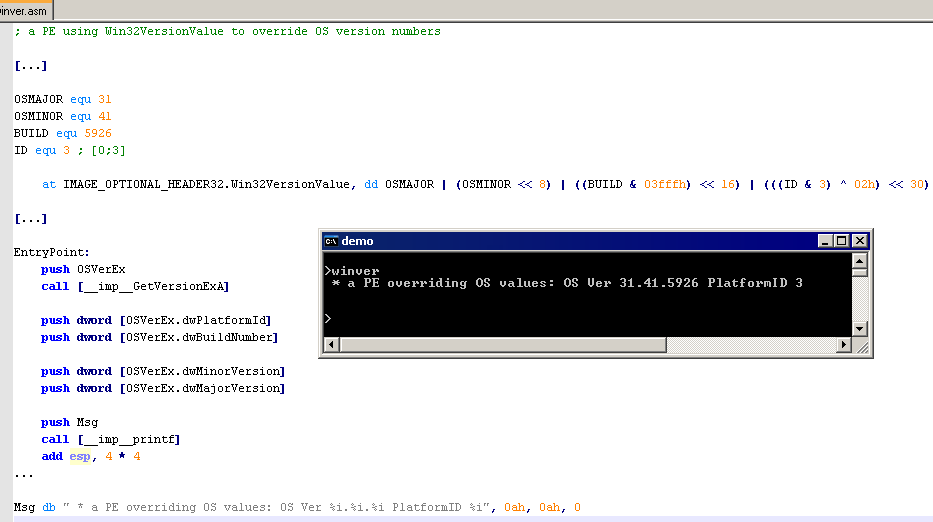
SizeOfImage- normally equal the total virtual size of all sections + headers
- 65535sects.exe has a SizeOfImage of 0x7027A000 (W7 only)
- tinyXP has a SizeOfImage of 0x2e. it only covers up to the EntryPoint value.
SizeOfHeaders- can be extended to the whole file, and sometimes be smaller than the header itself.
- foldedhdrW7.exe is a PE with standard alignments and a SizeOfHeaders of 1.
- maxsec_lowaligW7.exe has a SizeOfHeaders of 27570879.
CheckSumSubsystemFrom a technical perspective, drivers and gui/console PEs are identical, except that: - DRIVER need low alignments, a correct checksum, and to be signed under Vista or later (if not running in debug mode).
- a CONSOLE PE is exactly like a GUI PE except that it comes with a pre-attached console.
- multiss is a multi subsystem PE that will work correctly under all 3 subsystems, and display a message.
- determines the level of execution by checking CS
- resolve NTOSKRNL/KERNEL32 imports manually (by checksum, as it can't have any static import)
- in Dlls, Subsystem is ignored - it can have any value.
- dllfakess.dll has a Subsystem value of -1.
DllCharacteristics- not necessary
- dll.dll is a working DLL with this value set to 0
- 0080h IMAGE_DLLCHARACTERISTICS_FORCE_INTEGRITY enforces that the executable is signed before execution
- 0100h IMAGE_DLLCHARACTERISTICS_NX_COMPAT prevents code execution on the stack
- no_dep executes code on the stack, with no NX_COMPAT flag set
- dep executes code on the stack, which is forbidden as NX_COMPAT flag is set, and catches the exception
- 0400h IMAGE_DLLCHARACTERISTICS_NO_SEH (0400h) prevents the executable to uses Structured Exception Handler. Vectored Exception Handler still work.
- no_seh has NO_SEH set, triggers an exception, handled via its VEH.
- 1000h IMAGE_DLLCHARACTERISTICS_APPCONTAINER is only to be used by Metro Apps in Windows 8. A standard PE can't run under Windows 8 if this flag is set.
- 4000h IMAGE_DLLCHARACTERISTICS_GUARD_CF indicates that the file supports the Control Flow guard (data is in the LoadConfig entry), introduced in Windows 8.1.
SizeOfStackReserve/SizeOfStackCommit/SizeOfHeapReserve/SizeOfHeapCommit- can be zero, but not any value
- normal.exe has these value set to zero.
LoaderFlagsNumberOfRvaAndSizes- rounded down to 16 if bigger
- maxvals has a maximum of PE structures set to FF, including its NumberOfRvaAndSizes which is set to FFFF

- can be 0
- no_dd has no data directory (see imports)
- .Net loaders ignores this value, even if it requires relocations and a COM data directory, and will parse them. Thus, a .Net PE can work with a NumberOfRvaAndSizes of 2.

data directoriesexports- like many data directories, Exports' size are not necessary, except for forwarding (see below).
- Characteristics, TimeDateStamp, MajorVersion and MinorVersion are not necessary.
- Base is only used for ordinal imports
- dll.dll has a small export table, for one named entry:
at IMAGE_DATA_DIRECTORY_16.ExportsVA, dd Exports_Directory - IMAGEBASE
...
Exports_Directory:
Characteristics dd 0
TimeDateStamp dd 0
MajorVersion dw 0
MinorVersion dw 0
Name dd aDllName - IMAGEBASE
Base dd 0
NumberOfFunctions dd NUMBER_OF_FUNCTIONS
NumberOfNames dd NUMBER_OF_NAMES
AddressOfFunctions dd address_of_functions - IMAGEBASE
AddressOfNames dd address_of_names - IMAGEBASE
AddressOfNameOrdinals dd address_of_name_ordinals - IMAGEBASE
...
aDllName db 'dll.dll', 0
...
address_of_functions:
dd __exp__Export - IMAGEBASE
NUMBER_OF_FUNCTIONS equ ($ - address_of_functions) / 4
...
address_of_names:
dd a__exp__Export - IMAGEBASE
NUMBER_OF_NAMES equ ($ - address_of_names) / 4
...
address_of_name_ordinals:
dw 0
...
a__exp__Export db 'export', 0the Export Name is not necessary, and can be anything. - dllweirdexp.dll is correctly exported, with a corrupted Export Name

Exports_Directory:
...
Name dd VDELTA + aDllName - IMAGEBASE
...
aDllName db 'completely unrelated dll name', 1, 2, 3, 4, 0
AddressOfNames is lexicographically-ordered (like a dictionary): the pointer to a name starting with A shouldn't be after a name starting with B, and so on... - export_order has some exports wrongly ordered, which makes them unusable with the official loader.
...
push a_export
...
call [__imp__GetProcAddress]
jmp eax
...
push a_export2
...
call [__imp__GetProcAddress] ; we assume EAX==0 because it should fail
add eax, end_ - 07fh ; expected error code: 7fh
...
address_of_names:
dd a_export - IMAGEBASE
dd a_zz - IMAGEBASE
dd a_export2 - IMAGEBASEexport names can have any value (even null or more than 65536 characters long, with unprintable characters), just null terminated. - dllemptyexp-ld.exe loads dllemptyexp.dll with a null export

- dllweirdexp-ld.exe loads dllweirdexp.dll with a 131102-long non-Ascii export.
an .EXE can have exports (no need of relocation nor DLL flag), and can use them normally - ownexports.exe uses its own exports
- or they can be not used for execution, but for documenting the internal code
- PE_exports_doc has internal exports used as address symbols

- or they can have external or virtual addresses (but no address of 0, (un?)surprisingly)
- ownexports2 has a -1 export, to which it jumps (after adding 1). It also has an export in virtual space, which is executed.

exports at fixed value can be used to encode data, when their values are filled in the Import Address Table (their actual value doesn't matter as long as they are not executed, it's just a copied dword) - exportsdata.exe's code is stored as dodgy exports RVAs, and is restored when imports are resolved
EntryPoint:
ownexports.exe_iat:
dd 80000000h ; => dd 000101468h => 68 14100010 push 10001014
dd 80000001h ; => dd 04015FF10h => FF15 40100010 call [10001040]
dd 80000002h ; => dd 083100010h => 83C4 04 add esp,4
dd 80000003h ; => dd 0CCC304C4h => C3 retn
dd 0
...
Exports_Directory:
...
address_of_functions:
dd 000101468h - IMAGEBASE
dd 04015FF10h - IMAGEBASE
dd 083100010h - IMAGEBASE
dd 0CCC304C4h - IMAGEBASE
NBFUNCTIONS equ ($ - address_of_functions) / 4
...fake exports values can disrupt proper disassembly - exportobf.exe contains fake exports to make disassembly harder
ordinals-only exports can make the structure even smaller (no NumberOfFunctions/NumberOfNames/AddressOfNames/AddressOfNameOrdinals). Fake entries can be also present in exports as long as Base + Ordinal matches the wanted export. - impbyord.exe calls its own imports by ordinals
- dllord-ld.exe is importing export #314 from dllord.dll
dll.dll_iat:
__imp__export:
dd 1 << 31 | 314h ; highest bit set to indicate imports by ordinaldllord.dll Exports_Directory:
...
Base dd 313h
...
AddressOfFunctions dd address_of_functions - IMAGEBASE
...
address_of_functions:
dd -1 ; bogus entry that will be 313h
dd __exp__Export - IMAGEBASEexports can be used just to forward imports. in this case, the forwarded import is written as dll.API and must be within exportsVA and exportsVA+Size. - dllfw.dll forwards imports from msvcrt
address_of_functions:
dd amsvcrt_printf - IMAGEBASE
...
address_of_names:
dd a__exp__Export - IMAGEBASE
...
amsvcrt_printf db "msvcrt.printf", 0 ; forwarding string can only be within the official export directory bounds
a__exp__Export db 'ExitProcess', 0
EXPORTS_SIZE equ $ - Exports_Directoryexports can also forward each other and create loops - dllfwloop.dll forwards its own imports until the right API is called.

...
address_of_functions:
dd adllfwloop_loophere - IMAGEBASE
dd adllfwloop_looponceagain - IMAGEBASE
dd amsvcrt_printf - IMAGEBASE
dd adllfwloop_GroundHogDay - IMAGEBASE
dd adllfwloop_Yang - IMAGEBASE
dd adllfwloop_Ying - IMAGEBASE
NUMBER_OF_FUNCTIONS equ ($ - address_of_functions) / 4
_d
address_of_names:
dd a__exp__ExitProcess - IMAGEBASE
dd a__exp__LoopHere - IMAGEBASE
dd a__exp__LoopOnceAgain - IMAGEBASE
dd a__exp__GroundHogDay - IMAGEBASE
dd a__exp__Ying - IMAGEBASE
dd a__exp__Yang - IMAGEBASE
NUMBER_OF_NAMES equ ($ - address_of_names) / 4
...
imports- Imports size is not used.
- ImportAddressTable is typically not required (excepted in low alignments, under XP)
- dll-ld.exe imports dll.dll with a small import table:
at IMAGE_DATA_DIRECTORY_16.ImportsVA, dd Import_Descriptor - IMAGEBASE
...
EntryPoint:
call [__imp__export]
...
Import_Descriptor:
...
dll.dll_DESCRIPTOR:
dd dll.dll_hintnames - IMAGEBASE
dd 0, 0
dd dll.dll - IMAGEBASE
dd dll.dll_iat - IMAGEBASE
;terminator
dd 0, 0, 0, 0, 0
...
dll.dll_hintnames:
dd hndllexport - IMAGEBASE
dd 0
...
hndllexport:
dw 0
db 'export', 0
...
dll.dll_iat:
__imp__export:
dd hndllexport - IMAGEBASE
dd 0
...
dll.dll db 'dll.dll', 0under XP and later, a DLL can be called by his filename only (no extension). Extension is required under Win2K. - imports_noext.exe imports DLLs without extensions.
kernel32.dll db 'kernel32', 0
msvcrt.dll db 'msvcrt', 0 under XP, W8, but not W7, a file can be imported even if the imports name has trailing spaces/dots - importsdotXP uses standard APIs via names with trailing characters
kernel32.dll db 'kernel32.dll...', 0
msvcrt.dll db 'msvcrt.dll.', 0 importing your own exports with trailing characters might generate a crash in debuggers, and fail at loading. - ownexportsdot.exe imports himself, but as ownexportsdot.exe. ...
a DLL can be dynamically loaded via ANSI (LoadLibraryA) or UNICODE (LoadLibraryW). like in any filename, case of the DLL can be mixed - imports_mixed.exe imports DLLs with mixed case names.
kernel32.dll db 'KernEl32', 0
msvcrt.dll db 'mSVCrT', 0 the Import Lookup Table is not required and can be replaced by the Import Adress Table, or it can be just null - imports_noint.exe contains no ILT, the import descriptor are linking twice to the IAT.
...
Import_Descriptor:
kernel32.dll_DESCRIPTOR:
dd kernel32.dll_iat - IMAGEBASE
dd 0, 0
dd kernel32.dll - IMAGEBASE
dd kernel32.dll_iat - IMAGEBASE
...because it can be null, it can be put in virtual space, like the next 2 dwords (timestamp, forwarderchain) - imports_virtdesc has an import descriptor starting in virtual space over its 3 first dwords

if the Import Lookup Table is present, then it also determins the length of the Import Address Table, as they are parsed in parallel. In this case, the Import Address Table doesn't have to be null-terminated. - dllmaxvals has a non null-terminated IAT but a null-terminated ILT
if the IAT is linked in the descriptor but empty, then the DLL is not loaded, and the file is loaded even with an invalid dll name - the descriptor is skipped. - imports_nothunk has a bogus descriptor with an empty IAT, and a bogus DLL name, between real descriptors.
the imports directory is not compulsory (XP or later). either don't call any API (ex, resource placeholders), or locate Kernel32 and its exports by hand (see below, no_dd) the imports descriptor terminator just need to have null values. So, it can be placed in virtual space. - imports_vterm.exe has a virtual terminator
;terminator is partially in virtual space
dd msvcrt.dll_hintnames - IMAGEBASE
dd 0, 0
<EOF>the terminator of imports descriptor only needs to have its Name offset null, or its IAT. Then, the other values are not important. - imports_badterm has a bad terminator, that looks almost like a valid one:
...
;disguised terminator - dll address is 0
dd msvcrt.dll_hintnames - IMAGEBASE
dd 0, 0
dd 0 ;msvcrt.dll - IMAGEBASE
dd msvcrt.dll_iat - IMAGEBASE
... under Vista and Windows 7, the dll names can be redirected from API-MS-* to standard system DLLs by c:\windows\system32\apisecschema.dll, as documented by deroko - imports_apimsW7 imports ExitProcess via API-MS-Win-Core-Localization-L1-1-0.dll which is redirected during loading to kernel32.dll
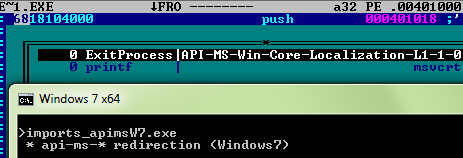
- as most fields of a descriptor are not necessary, it's possible to squeeze an overlapping IAT in it.
- imports_iatindesc.exe has IATs in descriptors
Import_Descriptor:
;kernel32.dll_DESCRIPTOR:
dd 0 ; can't put the IAT over this one
msvcrt.dll_iat:
__imp__printf:
dd hnprintf - IMAGEBASE
dd 0
dd kernel32.dll - IMAGEBASE
dd kernel32.dll_iat - IMAGEBASE
;msvcrt.dll_DESCRIPTOR:
dd 0
kernel32.dll_iat:
__imp__ExitProcess:
dd hnExitProcess - IMAGEBASE
dd 0
dd msvcrt.dll - IMAGEBASE
dd msvcrt.dll_iat - IMAGEBASE- imports_tiny combines a lot of these techniques with ordinals, to make a working imports structure as small as possible (40 bytes for 2 imports from 2 dlls)
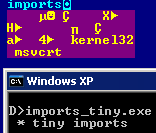
Import_Descriptor:
;kernel32.dll_DESCRIPTOR:
dd 0
msvcrt.dll_iat:
__imp__printf:
dd 80000000h + 742 ; printf
dd 0
dd kernel32.dll - IMAGEBASE
dd kernel32.dll_iat - IMAGEBASE
;msvcrt.dll_DESCRIPTOR:
dd 0
kernel32.dll_iat:
__imp__ExitProcess:
dd 80000000h + 183 ; ExitProcess
dd 0
dd msvcrt.dll - IMAGEBASE
dd msvcrt.dll_iat - IMAGEBASE
;terminator
kernel32.dll db 'kernel32' ,0 ; not W2k compatible
msvcrt.dll:
dd 'msvcrt',0
align 4, db 0 ; <= imports terminator NULL
- imports' Data Directory is not required to load imports: by locating kernel32 manually then parsing its exports manually, it's possible to resolve LoadLibraryA, then it's possible to manually load any DLL and resolve any of its exports (manually or via GetProcAddress).
- no_dd has no data directory, and loads its imports manually.

- .Net requires an import to mscoree.dll._CoreExeMain, and an import size to be at least 0x28.
It doesn't accept to import to mscoree (without extension).
resources- directory-like structure.
...
at IMAGE_DATA_DIRECTORY_16.ResourceVA, dd Directory_Entry_Resource - IMAGEBASE
...
push SOME_TYPE ; lpType
push SOME_NAME ; lpName
push 0 ; hModule
call [__imp__FindResourceA]
...
Directory_Entry_Resource:
; root directory
istruc IMAGE_RESOURCE_DIRECTORY
at IMAGE_RESOURCE_DIRECTORY.NumberOfIdEntries, dw 1
iend
istruc IMAGE_RESOURCE_DIRECTORY_ENTRY
at IMAGE_RESOURCE_DIRECTORY_ENTRY.NameID, dd SOME_TYPE ; .. resource type of that directory
at IMAGE_RESOURCE_DIRECTORY_ENTRY.OffsetToData, dd (1<<31) | (resource_directory_type - Directory_Entry_Resource)
iend
resource_directory_type:
istruc IMAGE_RESOURCE_DIRECTORY
at IMAGE_RESOURCE_DIRECTORY.NumberOfIdEntries, dw 1
iend
istruc IMAGE_RESOURCE_DIRECTORY_ENTRY
at IMAGE_RESOURCE_DIRECTORY_ENTRY.NameID, dd SOME_NAME ; name of the underneath resource
at IMAGE_RESOURCE_DIRECTORY_ENTRY.OffsetToData, dd (1<<31) | (resource_directory_language - Directory_Entry_Resource)
iend
resource_directory_language:
istruc IMAGE_RESOURCE_DIRECTORY
at IMAGE_RESOURCE_DIRECTORY.NumberOfIdEntries, dw 1
iend
istruc IMAGE_RESOURCE_DIRECTORY_ENTRY
at IMAGE_RESOURCE_DIRECTORY_ENTRY.OffsetToData, dd resource_entry - Directory_Entry_Resource
iend
resource_entry:
istruc IMAGE_RESOURCE_DATA_ENTRY
at IMAGE_RESOURCE_DATA_ENTRY.OffsetToData, dd resource_data - IMAGEBASE
at IMAGE_RESOURCE_DATA_ENTRY.Size1, dd RESOURCE_SIZE
iend
resource_data:
Msg db " * message stored in resources", 0ah, 0
RESOURCE_SIZE equ $ - resource_datain standard, 3 levels: Root/Type/Name/Language but anything else is possible. - loops are possible
- resourceloop.exe contains several loops between resource directories
resource_directory_type:
...
at IMAGE_RESOURCE_DIRECTORY_ENTRY.OffsetToData, dd (1<<31) | (resource_directory_loop - Directory_Entry_Resource)
...
resource_directory_loop:
...
; double level recursivity
...
at IMAGE_RESOURCE_DIRECTORY_ENTRY.OffsetToData, dd (1<<31) | (resource_directory_type - Directory_Entry_Resource)
...
; direct recursivity
...
at IMAGE_RESOURCE_DIRECTORY_ENTRY.OffsetToData, dd (1<<31) | (resource_directory_loop - Directory_Entry_Resource)- Names and Types of a resource can be used:
- immediate integers (aka IDs) - like resource.exe
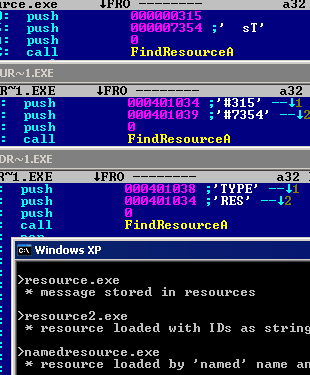
SOME_TYPE equ 315h
SOME_NAME equ 7354h
...
push SOME_TYPE ; lpType
push SOME_NAME ; lpName
push 0 ; hModule
call [__imp__FindResourceA]
...
at IMAGE_RESOURCE_DIRECTORY_ENTRY.NameID, dd SOME_TYPE ; .. resource type of that directory
...
at IMAGE_RESOURCE_DIRECTORY_ENTRY.NameID, dd SOME_NAME ; name of the underneath resource
- immediate integers (aka IDs) converted as string for loading - like resource2.exe
push atype ; lpType
push ares ; lpName
push 0 ; hModule
call [__imp__FindResourceA]
...
atype db '#315', 0
ares db "#7354", 0
...
SOME_TYPE equ 315
SOME_NAME equ 7354
...
at IMAGE_RESOURCE_DIRECTORY_ENTRY.NameID, dd SOME_TYPE ; .. resource type of that directory
...
at IMAGE_RESOURCE_DIRECTORY_ENTRY.NameID, dd SOME_NAME ; name of the underneath resource
... strings (aka Names). the Name in resource directory is with the format length + widestring - like namedresource.exe push arestype ; lpType
push aresname ; lpName
push 0 ; hModule
call [__imp__FindResourceA]
...
aresname db 'RES', 0
arestype db 'TYPE', 0
...
.NumberOfNamedEntries dw 0
.NumberOfIdEntries dw 1
.ID dd (1 << 31) | (alrestype - resource_directory) ; .. resource type of that directory
...
.NumberOfNamedEntries dw 0
.NumberOfIdEntries dw 1
.ID dd (1 << 31) | (alresname - resource_directory) ; name of the underneath resource
...
; length + widestring
alresname dw 3, "R", "E", "S", 0
alrestype dw 4, "T", "Y", "P", "E", 0the resource structures are relative to the start of the Data Directory, but the resource data can be anywhere in the file (RVA) - reshdr.exe has its resource data in the PE header
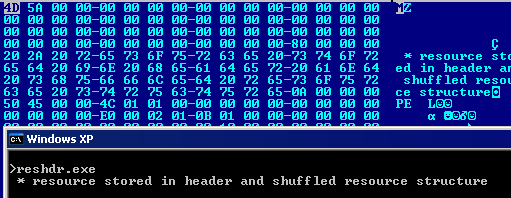
at IMAGE_DOS_HEADER.e_magic, db 'MZ'
at IMAGE_DOS_HEADER.e_lfanew, dd NT_Signature - IMAGEBASE
...
resource_data:
Msg db " * resource stored in header and shuffled resource structure", 0ah, 0
RESOURCE_SIZE equ $ - resource_data
resource strings have their own awkward format, in which 16 strings are stored in each block, and a null string is equivalent to no string, as all strings of the same block are stored consecutively as <length16><string>. - resource_string stores and access its message via resource string
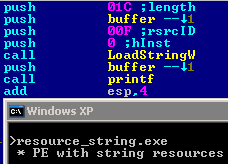
Version information- version information is a resource of type RT_VERSION 0x10 (16)
- thus, parsing version informations requires Data directories and resource parsing, which is not-trivial in extreme cases (folded headers, resource loops...). It might be preferable to just check the FILE_HEADER's TimeDateStamp (which is straightforward, see hard_imports) if you just require some minor version check.
- under XP, the resource DataDirectory has to start at the beginning of its own section, or the properties dialog fails to parse the resources.
- the VS_FIXEDFILEINFO structure is required as well as it's signature, even if not used.
version_cust contains minimal version informations, which generates the version tab but doesn't show any information
...
at IMAGE_RESOURCE_DIRECTORY_ENTRY.NameID, dd RT_VERSION ; .. resource type
...
resource_data:
VS_VERSION_INFO:
.wLength dw VERSIONLENGTH
.wValueLength dw VALUELENGTH
.wType dw 0 ; 0 = bin, 1 = text
WIDE 'VS_VERSION_INFO'
align 4, db 0
Value:
istruc VS_FIXEDFILEINFO
at VS_FIXEDFILEINFO.dwSignature, dd 0FEEF04BDh
iend
VALUELENGTH equ $ - Value
align 4, db 0
; no children
VERSIONLENGTH equ $ - VS_VERSION_INFO
RESOURCE_SIZE equ $ - resource_data - version_mini implements a children StringFileInfo structure, which actually displays some minimal version information (and crashes Windows XP explorer).
; children
StringFileInfo:
dw STRINGFILEINFOLEN
dw 0 ; no value
dw 0 ; type
WIDE 'StringFileInfo'
align 4, db 0
; children
StringTable:
dw STRINGTABLELEN
dw 0 ; no value
dw 0
WIDE '040904b0' ; required correct
align 4, db 0
;children
; required or won't be displayed by explorer
__string 'FileVersion', ''
STRINGTABLELEN equ $ - StringTable
STRINGFILEINFOLEN equ $ - StringFileInfothe FixedFileInfo structure can contain any value besides its signature. version_std contains only FFs in it. istruc VS_FIXEDFILEINFO
at VS_FIXEDFILEINFO.dwSignature, dd 0FEEF04BDh
times 6 dd 0ffffffffh
iendthe StringFileInfo structure accepts standard values, but also unknown strings, empty strings and duplicates. __string 'FileVersion', 'compulsory for version tab'
__string 'LegalCopyright', 'corkami.com'
__string 'StringFileInfo', ''
__string 'Comments', ''
__string 'CompanyName', ''
__string 'InternalName', ''
__string 'LegalTrademarks', ''
__string 'OriginalFilename', ''
__string 'PrivateBuild', ''
__string 'ProductName', ''
__string 'ProductVersion', ''
__string 'SpecialBuild', ''
__string '', ''
__string ' ', ''
__string ' ** EAT AT JOE"S **', 'best hamburger in town'
__string 'FileVersion', 'duplicates are authorized' Manifest- Manifest are XML resource that store informations about the executable.
- Manifest presence can be checked by kernel32.CreateActCtxA
- the minimal Manifest is <assembly xmlns='urn:schemas-microsoft-com:asm.v1' manifestVersion='1.0'/>
- XP SP2 used to BSOD with a simple manifest PE
- a PE with an incorrect manifest resource won't run
- a manifest with an invalid type will be ignored, thus the file will run.
- manifest_broken has an invalid manifest with an invalid type, so it's ignored altogether
...
MYMAN equ 3 ; incorrect - this file wouldn't run if it's set to 1 or 2
...
at IMAGE_RESOURCE_DIRECTORY_ENTRY.NameID, dd MYMAN
...
resource_data:
db "<assembly xmlns='urn:schemas-microsoft-com:asm.v1' manifestVersion='1.0'>" ; broken end
RESOURCE_SIZE equ $ - resource_data
...exception- used by 64b binaries for structured exception handling.
- exceptions is a minimalist 64b PE that use exceptions.
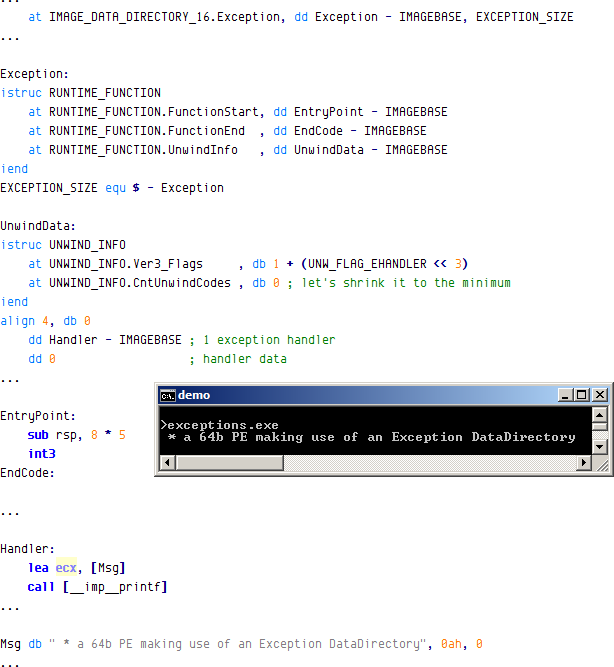
- the OS relies on the DataDirectory itself in memory.
- seh_change64 alterates the handler in memory, which is taken into account by the OS.
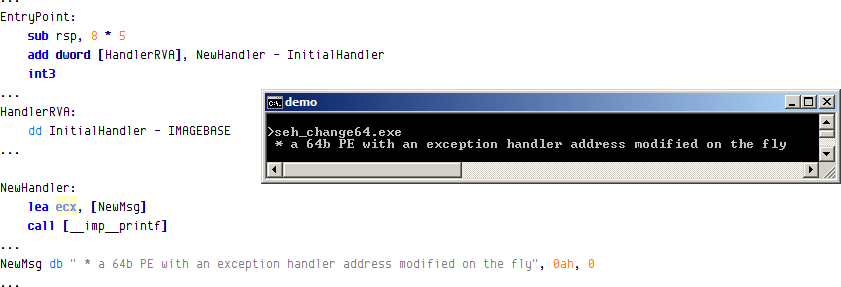
security- defines the offset and size of the digital certificate blob (as it can be appended after appended data itself).
- the area covered by this data directory is not included in the signature checking. Thus, increasing the size of a certificate and appending some data that won't be checked is possible without breaking the signature. This leads to security problems if the file is an installer with a ZIP in appended data / last section, as ZIPs are parsed bottom-up.
- moreover, it was possible to move the certificate so that its starts overlaps IMAGE_DOS_HEADER.e_lfanew, which could lead to an alternate IMAGE_NT_HEADERS being used - thus, a different PE - while the signature is still valid.
relocations at IMAGE_DATA_DIRECTORY_16.FixupsVA, dd Directory_Entry_Basereloc - IMAGEBASE
at IMAGE_DATA_DIRECTORY_16.FixupsSize, dd DIRECTORY_ENTRY_BASERELOC_SIZE
...
reloc01:
push detach
reloc22:
call [__imp__printf]
...
Directory_Entry_Basereloc:
block_start0:
.VirtualAddress dd reloc01 - IMAGEBASE
.SizeOfBlock dd BASE_RELOC_SIZE_OF_BLOCK0
dw (IMAGE_REL_BASED_HIGHLOW << 12) | (reloc01 + 1 - reloc01)
dw (IMAGE_REL_BASED_HIGHLOW << 12) | (reloc22 + 2 - reloc01)
BASE_RELOC_SIZE_OF_BLOCK0 equ $ - block_start0
...
DIRECTORY_ENTRY_BASERELOC_SIZE equ $ - Directory_Entry_Basereloc- forcing the binary to relocate to a known place (ex, with a null or kernel ImageBase) makes it possible for the relocations to have predictable behavior. Thus, they can be used to decrypt or clear some values in memory. Also, relocations may be used to modify themselves.
- reloccrypt.exe has a 0ffff0000h ImageBase, and its relocations are, first, modifying themselves, using uncommon relocation types, then decrypting the code to be executed.
EntryPoint:
reloc01: ;68h push VDELTA + msg
crypt168 db 0
dd VDELTA + msg
...
Directory_Entry_Basereloc:
; this block will fix the SizeOfBlock of the next block
block_start:
.VirtualAddress dd VDELTA + relocated_reloc - IMAGEBASE
.SizeOfBlock dd BASE_RELOC_SIZE_OF_BLOCK
dw (IMAGE_REL_BASED_HIGHLOW << 12) ; + 10000h
dw (IMAGE_REL_BASED_ABSOLUTE << 12)
dw (IMAGE_REL_BASED_HIGHLOW << 12) ; + 10000h
dw (IMAGE_REL_BASED_HIGHADJ << 12)
dw (IMAGE_REL_BASED_HIGH << 12) ; + 00001h
dw (IMAGE_REL_BASED_LOW << 12) ; + 0
dw (IMAGE_REL_BASED_SECTION << 12)
dw (IMAGE_REL_BASED_REL32 << 12)
...
;this block is actually the genuine relocations
block_start0:
.VirtualAddress dd VDELTA + reloc01 - IMAGEBASE
relocated_reloc:
.SizeOfBlock dd BASE_RELOC_SIZE_OF_BLOCK0 - 40002h
...
%macro cryptblock 2
block_start%1:
.VirtualAddress dd VDELTA + %1 - IMAGEBASE
.SizeOfBlock dd BASE_RELOC_SIZE_OF_BLOCK%1
dw (IMAGE_REL_BASED_ABSOLUTE << 12)
times %2 / 2 dw (IMAGE_REL_BASED_HIGH << 12)
BASE_RELOC_SIZE_OF_BLOCK%1 equ $ - block_start%1
%endmacro
;these blocks are the ones to implement the decryption
cryptblock crypt168, 068h
...- applying a relocation on e_lfanew alters the remaining part of the loading process: under Vista and later, the remaining DataDirectories such as imports are parsed after relocations are processed. If e_lfanew is relocated, then a different PE Header (almost empty) can be used, thus an entirely different set of DataDirectories can be used.

- lfanew_relocW7.exe implements such a trick:
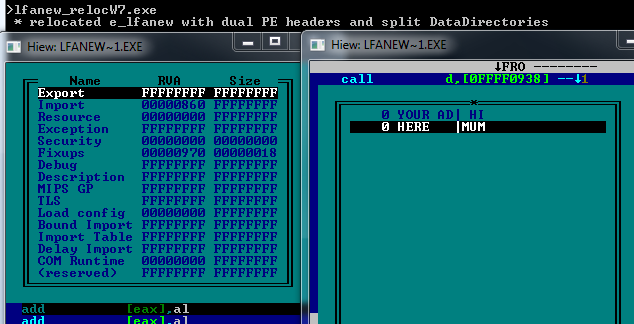
debug- used for storing debug symbols
- its DataDirectory size tells the loader how many blocks are available. Thus, it is taken into account.
- under XP, the value of the Debug directory SIZE can't be random - even if the RVA is null !
copyright- Watcom compilers makes it point to a string. Useless whatsoever.
GlobalPtr- used in Itanium to store global pointers to variables. Useless whatsoever.
TLS- most values of TLS structures are not required:
- tls.exe executes TLS code with the following structure
at IMAGE_DATA_DIRECTORY_16.TLSVA, dd Image_Tls_Directory32 - IMAGEBASE
...
Image_Tls_Directory32:
StartAddressOfRawData dd 0
EndAddressOfRawData dd 0
AddressOfIndex dd some_value
AddressOfCallBacks dd CallBacks
SizeOfZeroFill dd 0
Characteristics dd 0
...
some_value dd 012345h
CallBacks:
dd tls
dd 0
...
tls:
<...>The callbacks are VAs, not RVAs (ImageBase is included). each callback is executed until an error happens or a null dword is next in the list. then, no matter what happened (error or not) the EntryPoint is executed: - a TLS doesn't need to return cleanly if it knows it's the last one
- an incorrect entry in the list doesn't trigger a visible error
- tls_obfuscation.exe has many fake TLS callback entries to disrupt disassembly

like the entrypoint value, a callback VA is blindly called. It can be: - outside the PE, in a known in advance address
- pointing an Import Address Table entry, which means an API will be called with ImageBase as parameter.
- tls_import.exe executes mz.exe via a call to WinExec through a TLS callback in its IAT.
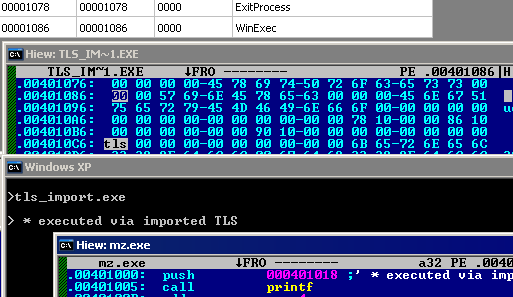
under XP, TLS are only executed with staticly loaded DLL, not dynamicly loaded ones. on XP, TLS are executed twice, on process start and process termination. Thus, code is executed even after a call to ExitProcess. This is true even under Windows 7, however libraries such as user32.dll might be already unloaded, preventing code using it to work normally.
- TLS callbacks are not executed on thread start if no DLL importing kernel32 is imported. Thus, only execution on thread stop if kernel32 is the only import.
- tls_k32 only has imports to kernel32, and a TLS that is ignored on thread start and used on thread stop, while the EntryPoint code is meaningless.
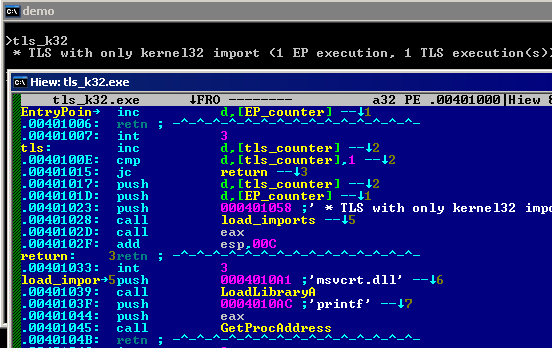
- this behavior might be altered if the OS or debugger is loading an extra DLL.
- TLS callbacks' list is updated at each callback execution. If a TLS or the EntryPoint code add or remove an entry, it will be taken into consideration
- tls_onthefly's first TLS adds a second one on the list that will be executed directly after the first one is over
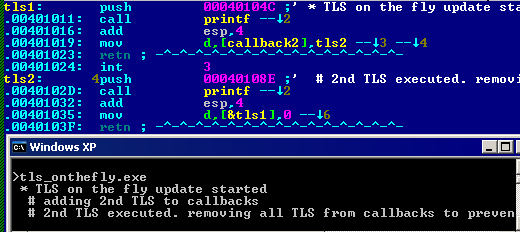
tls:
...
mov dword [CallBacks + 4], tls2
retn
...
tls2:
...
- if a callback calls ExitProcess, the EntryPoint won't be called, however the callback will be executed after the ExitProcess call
- tls_exiting.exe contains an exiting TLS callback, preventing the EntryPoint code to be ever called.
- tls_noEP.exe contains no EntryPoint, its callback calls ExitProcess, then the first callback is called again.
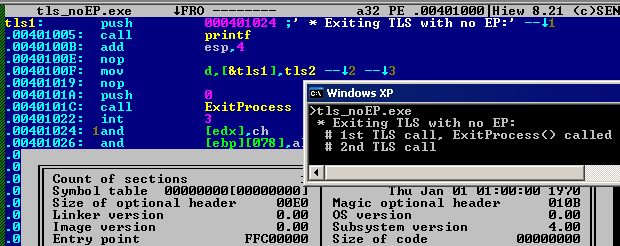
...
at IMAGE_OPTIONAL_HEADER32.AddressOfEntryPoint, dd 0 - IMAGEBASE
...
tls:
...
mov dword [CallBacks], tls2
...
call [__imp__ExitProcess]
...
tls2:
push TLSEnd
call [__imp__printf]
- like DllMain, after TLS execution, only ESI needs to be correct. the rest doesn't matter, including ESP, which could easily crash an emulator.
- fakeregs corrupts all registers except ESI, on DllMain and TLS execution.
LoadConfig- stores various OS related flags, including the SafeSEH structure, which prevents the execution of an exception handler by terminating the process if that handler is not in the Handler table. This is an OS mechanism, not specific to a compiler.
- safeseh.exe defines a minimal SafeSEH structure manually
at IMAGE_DATA_DIRECTORY_16.Load, dd LoadConfig - IMAGEBASE, 40h ; fixed XP value?
...
LoadConfig:
istruc IMAGE_LOAD_CONFIG_DIRECTORY32
at IMAGE_LOAD_CONFIG_DIRECTORY32.Size, dd IMAGE_LOAD_CONFIG_DIRECTORY32_size
...
at IMAGE_LOAD_CONFIG_DIRECTORY32.SecurityCookie, dd cookie
at IMAGE_LOAD_CONFIG_DIRECTORY32.SEHandlerTable, dd HandlerTable
at IMAGE_LOAD_CONFIG_DIRECTORY32.SEHandlerCount, dd HANDLERCOUNT
iend
HandlerTable:
...
HANDLERCOUNT equ ($ - HandlerTable) / 4- the handler table is not protected, it's just aiming at preventing a blind exception handler change
- safeseh_fly.exe sets a SEH on the fly and uses it:
...
mov dword [HandlerTable], Handler - IMAGEBASE
int3
...- ldrsnaps sets its FLG_SHOW_LDR_SNAPS GlobalFlags and checks it (also works in 64 bits with ldrsnaps64
...
call [__imp__RtlGetNtGlobalFlags]
...
at IMAGE_LOAD_CONFIG_DIRECTORY32.GlobalFlagsSet, dd FLG_SHOW_LDR_SNAPS
...Bound imports- are a shortcut structure to hardcode some imports values in advance, to make import values faster
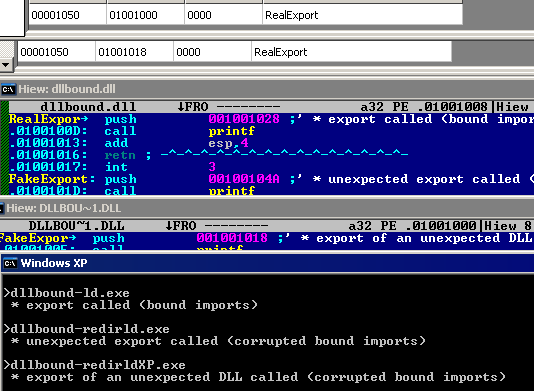
- all the loader does is take a filename, compare the timestamp of the file and the one included in the bound imports table, then use the VA directly as import if they match.
- dllbound-ld.exe loads and execute 'dllbound.dll' via bound imports.
at IMAGE_DATA_DIRECTORY_16.BoundImportsVA, dd BoundImports - IMAGEBASE
...
BoundImports:
dd 31415925h ; timestamp of the bound DLL
dw bounddll - BoundImports ; it's a WORD relative offset :(
dw 0
...
bounddll db 'dllbound.dll', 0 ; we have to duplicate locally this string... :(
...
dll.dll_iat:
__imp__export:
dd 01001008h ;VA of the export of the loaded DLL- thus, replacing the RVA in the bound import table is an easy way to redirect imports.
- dllbound-redirld.exe will load the wrong import of dllbound.dll because one RVA has been changed.
dll.dll_iat:
__imp__export:
dd 01001018h ; corrupted VA of the import - under XP only, it's even possible to put a different filename and timestamp. a completely different DLL will be used no matter what the standard import table says.
- dllbound-redirldXP.exe will load the wrong dll dllbound2.dll, as the name and timestamp have been modified.
BoundImports:
dd 27182818h ; timestamp of the hijacking DLL
dw bounddll - BoundImports
dw 0
;terminator
dd 0, 0
bounddll db 'dllbound2.dll', 0 ; hijacking DLL name Import table- the RVA and the Size required to be set on a low alignment PE to make the import table writeable, under XP.
- nosectionXP.exe needs an IAT to make its imports writeable
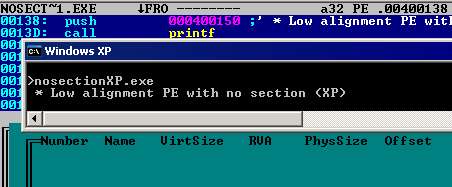
delay imports- is a rip-off, a fake structure.
- delay_corrupt.exe contains completely corrupted delay imports, which doesn't alterate the file loading and running.
- is just a trampoline added by the compiler to load imports and DLL on request,
with a 'frontend' in the data directories, with a structure similar to standard imports (adress table + name table) so that external tools can still indicate that imports calls are present.
- delayimports.exe has working delay imports (displayed by other tools):

...
at IMAGE_DATA_DIRECTORY_16.DelayImportsVA, dd delay_imports - IMAGEBASE
at IMAGE_DATA_DIRECTORY_16.DelayImportsSize, dd DELAY_IMPORTS_SIZE
...
delay_imports:
istruc _IMAGE_DELAY_IMPORT_DESCRIPTOR
at _IMAGE_DELAY_IMPORT_DESCRIPTOR.rvaDLLName, dd msvcrt.dll
at _IMAGE_DELAY_IMPORT_DESCRIPTOR.rvaIAT, dd delay_iat - IMAGEBASE
at _IMAGE_DELAY_IMPORT_DESCRIPTOR.rvaINT, dd msvcrt_int
iend
istruc _IMAGE_DELAY_IMPORT_DESCRIPTOR
iend
delay_iat:
__imp__printf:
dd __delay__printf
dd 0
- the information in the header is not required to make delay import works, are they are extra code added in the file by the compiler.
- Erasing the data directory VA from a standard file with delay imports will not disturb its execution
- delaycorrupt.exe has the same structure as delayimports.exe, but the descriptors are empty.

...
delay_imports:
istruc _IMAGE_DELAY_IMPORT_DESCRIPTOR
iend
...
COM Runtime- not covered here
- used in .Net files to store information of the actual .Net structures
reserved- used by packers and malware as markers
section table- the section table doesn't have to be fully covered by SizeOfHeaders. (cf truncsectbl.exe)
NameMisc_VirtualSize- bigsec has a section with a virtual size of 0x10001000 (and executes code at the bottom of it).
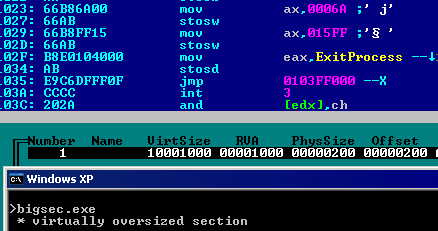
...
extravirtualspace equ 010000h
at IMAGE_OPTIONAL_HEADER32.SizeOfImage, dd (2 + extravirtualspace) * SECTIONALIGN
...
at IMAGE_SECTION_HEADER.VirtualSize, dd (1 + extravirtualspace) * SECTIONALIGN
...
EntryPoint:
VirtualStart equ (extravirtualspace - 1) * SECTIONALIGN + IMAGEBASE
mov edi, VirtualStart
; 68 xxxxxxxx push Msg
mov al, 68h
stosb
mov eax, Msg
stosd
...
jmp VirtualStart
- a section can have a null VirtualSize: in this case, only the SizeOfRawData is taken into consideration.
- nullvirt has a section with a null VirtualSize and a non-null SizeOfRawData.
VirtualAddress- sections have to be in increasing order, virtually.
- A section can start before the previous one ends. Which means that offset-wise, the address is not constantly increasing.
- secinsec.exe has a 1x-sized section inside the previous 3x-sized section
SectionHeader:
istruc IMAGE_SECTION_HEADER
at IMAGE_SECTION_HEADER.VirtualSize, dd 1 * SECTIONALIGN
at IMAGE_SECTION_HEADER.VirtualAddress, dd 1 * SECTIONALIGN
at IMAGE_SECTION_HEADER.SizeOfRawData, dd 3 * FILEALIGN
at IMAGE_SECTION_HEADER.PointerToRawData, dd 1 * FILEALIGN
iend
istruc IMAGE_SECTION_HEADER
at IMAGE_SECTION_HEADER.VirtualSize, dd 1 * SECTIONALIGN
at IMAGE_SECTION_HEADER.VirtualAddress, dd 2 * SECTIONALIGN
at IMAGE_SECTION_HEADER.SizeOfRawData, dd 1 * FILEALIGN
at IMAGE_SECTION_HEADER.PointerToRawData, dd 2 * FILEALIGN
iendsections don't have to be virtually contiguous - virtgap introduces a gap of 10000000h between 2 sections.

SizeOfRawDataPointerToRawData- sections can be physically overlapping.
- dupsec has 2 identical sections (besides the VirtualAddress)
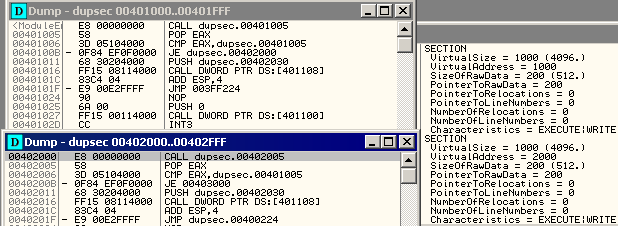
SectionHeader:
istruc IMAGE_SECTION_HEADER
at IMAGE_SECTION_HEADER.VirtualSize, dd 1 * SECTIONALIGN
at IMAGE_SECTION_HEADER.VirtualAddress, dd 1 * SECTIONALIGN
at IMAGE_SECTION_HEADER.SizeOfRawData, dd 1 * FILEALIGN
at IMAGE_SECTION_HEADER.PointerToRawData, dd 1 * FILEALIGN
at IMAGE_SECTION_HEADER.Characteristics, dd IMAGE_SCN_MEM_EXECUTE | IMAGE_SCN_MEM_WRITE
iend
istruc IMAGE_SECTION_HEADER
at IMAGE_SECTION_HEADER.VirtualSize, dd 1 * SECTIONALIGN
at IMAGE_SECTION_HEADER.VirtualAddress, dd 2 * SECTIONALIGN
at IMAGE_SECTION_HEADER.SizeOfRawData, dd 1 * FILEALIGN
at IMAGE_SECTION_HEADER.PointerToRawData, dd 1 * FILEALIGN
at IMAGE_SECTION_HEADER.Characteristics, dd IMAGE_SCN_MEM_EXECUTE | IMAGE_SCN_MEM_WRITE
iend
- if a section starts at offset 0, it's invalid.
- if a section's physical start is lower than 200h (the lower limit for standard alignment), it is rounded down to 0. Thus, it's a legitimate way to map the header.
- duphead.exe maps the header in a section via rounding down it's physical start:

at IMAGE_SECTION_HEADER.PointerToRawData, dd 1ffh ; upper limit of the down-rounding trick
- sections can be in wrong order physically
- shuffledsect.exe has sections in a wrong physical order.

SectionHeader:
istruc IMAGE_SECTION_HEADER
at IMAGE_SECTION_HEADER.VirtualSize, dd 1 * SECTIONALIGN
at IMAGE_SECTION_HEADER.VirtualAddress, dd 1 * SECTIONALIGN
at IMAGE_SECTION_HEADER.SizeOfRawData, dd FILEALIGN
at IMAGE_SECTION_HEADER.PointerToRawData, dd 2 * FILEALIGN
...
iend
istruc IMAGE_SECTION_HEADER
at IMAGE_SECTION_HEADER.VirtualSize, dd 1 * SECTIONALIGN
at IMAGE_SECTION_HEADER.VirtualAddress, dd 2 * SECTIONALIGN
at IMAGE_SECTION_HEADER.SizeOfRawData, dd FILEALIGN
at IMAGE_SECTION_HEADER.PointerToRawData, dd 1 * FILEALIGN
- sections can leave a physically unused space in the PE
- slackspace.exe has 2 section leaving an unused physical space in between

...
SectionHeader:
istruc IMAGE_SECTION_HEADER
at IMAGE_SECTION_HEADER.VirtualSize, dd SECTIONALIGN
at IMAGE_SECTION_HEADER.VirtualAddress, dd SECTIONALIGN
at IMAGE_SECTION_HEADER.SizeOfRawData, dd FILEALIGN
at IMAGE_SECTION_HEADER.PointerToRawData, dd FILEALIGN
...
iend
istruc IMAGE_SECTION_HEADER
at IMAGE_SECTION_HEADER.VirtualSize, dd SECTIONALIGN
at IMAGE_SECTION_HEADER.VirtualAddress, dd SECTIONALIGN * 2
at IMAGE_SECTION_HEADER.SizeOfRawData, dd FILEALIGN
at IMAGE_SECTION_HEADER.PointerToRawData, dd 3 * FILEALIGN
...
- the physically-last section defines the appended data. However, it's easy to 'hide' appended data by either:
- adding a fake extra section (even physically one byte), such as in hiddenappdata1 (creating some slackspace)
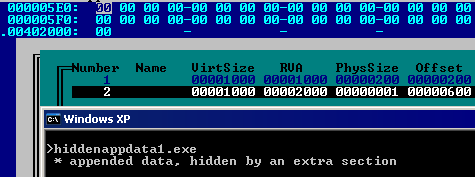
- enlarging the physically-last section, such as in hiddenappdata2
PointerToRelocations/PointerToLinenumbers/NumberOfRelocations/NumberOfLinenumbersCharacteristics- to be detailed here later - check the examples.
extra64ba 64b PE (PE32+) is like a 32b PE, except that the FILE HEADER's Machine and the OPTIONAL HEADER's Magic have AMD specific values, and the Imports's INT, as well as the ImageBase, and the Stack and Heap info are QWORD (which drops a few fields from the Optional header as a consequence 
...
at IMAGE_FILE_HEADER.Machine, dw IMAGE_FILE_MACHINE_AMD64
...
at IMAGE_OPTIONAL_HEADER64.Magic, dw IMAGE_NT_OPTIONAL_HDR64_MAGIC
...
.ImageBase resq 1
...
.SizeOfStackReserve resq 1
.SizeOfStackCommit resq 1
.SizeOfHeapReserve resq 1
.SizeOfHeapCommit resq 1
.LoaderFlags resd 1
...
kernel32.dll_hintnames:
dq hnExitProcess - IMAGEBASE
dq 0minimal sizesthe minimal size for a PE is: - 97 bytes, under XP: tinyXP. In this case, the OptionalHeader is truncated.
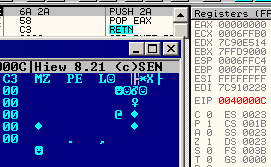
- the same rule applies to drivers

- and DLLs: tinydllXP
- 252 bytes, under Vista/Windows 7 (the same as under XP, with null padding): tinyW7 - as the OS now enforces a minimum of physical space after the start of the OptionalHeader.
- 268 bytes, under Vista/Windows 7 (same again, just null bytes to get the required size, but the same elements as tinyXP)
- in 32b, tinyW7_3264
- in 64b, tinyW7x64
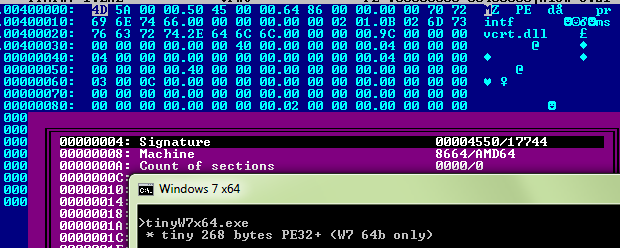
so, 268 bytes is the smallest size for a universal tiny PE.

specific casesfolded header- found out by Reversing Labs as 'Dual PE Header'
- the first checks of the PE are done on file. then the file is loaded in memory. then imports are resolved, from the image in memory.
- by extending the header until the first SectionAlignment, it's possible to have the first section overlapping the header partially.
thus, the actual data directories used for imports resolving will not be the contiguous ones on the disk.

...
section progbits vstart=IMAGEBASE + SECTIONALIGN align=FILEALIGN
;---------------------------------------------- CUT and FOLD here ----------------------------------
; ok here we're at RVA 1000h (start of 1st section),
; so this data will overwrite the PE headers originally loaded from offset F80h, physically further in the file.
dd Import_Descriptor - IMAGEBASE, 0
...
times 0f80h - FILEALIGN * 2 db 0 ; to make the header overlap on address offset/rva 1000h
NT_Signature:
istruc IMAGE_NT_HEADERS
at IMAGE_NT_HEADERS.Signature, db 'PE', 0, 0
iend
...
istruc IMAGE_DATA_DIRECTORY_16
dd 88660001h,010009988h
;---------------------------------------------- CUT and FOLD here ----------------------------------
; we cut the header here, and we're right at offset 1000h
;---------------------------------------------- CUT and FOLD here ----------------------------------
dd 86600010h,001000998h
dd 66000100h,000100099h
dd 6000100Fh,0F0010009h
... PE + PDF + ZIP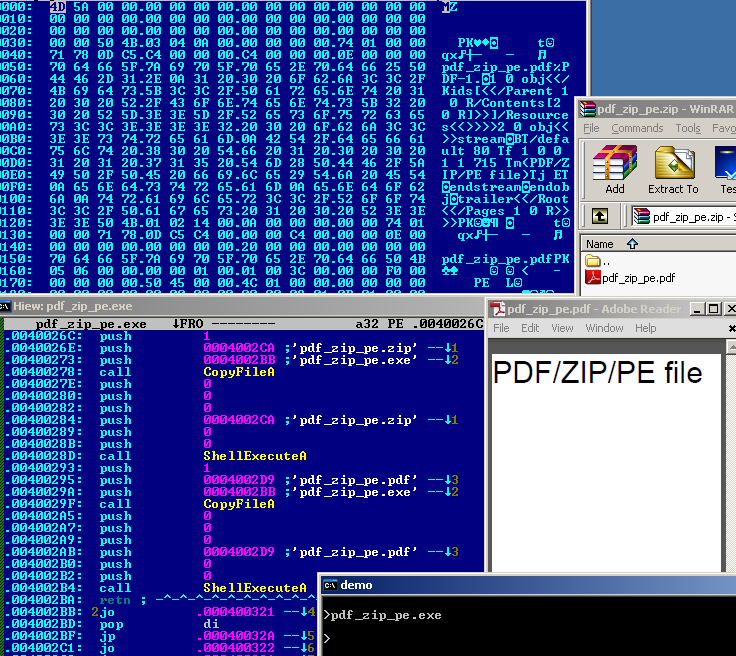
- PDF in/and ZIP:
- PDF documents don't need to have their signature starting at offset 0
- in a ZIP archive with no compression, the file is stored in its original form
So it's possible to make a ZIP containing a PDF that also works as the PDF itself. - ZIP archives also don't need to start at offset 0
- so a PE can contain such a ZIP, and work as both a PE and a ZIP
- moving the 'PE' headers far enough via increasing e_lfanew enables to store any size of file in the PE
so it's possible to make a PE containing a ZIP containing a uncompressed PDF, that works as both a document (PDF), an archive (ZIP), and an executable (PE), like pdf_zip_pe.exe. File formats should have enforce their signature at offset 0. file walkthrough- start of the file (as a PE):
00000000: 4D 5A 00 00 00 00 00 00 00 00 00 00 00 00 00 00 MZ.............. - start of the ZIP archive:
00000030: 50 4B 03 04 0A 00 00 00 00 00 74 01 00 00 PK???.....t?..\ - e_lfanew pointing to the PE header (PE) (overlapping ZIP's lastmod)
00000030: 74 01 00 00 t?.. - PDF signature (PDF):
00000050: 25 50 %P
00000060: 44 46 2D 31.2E 0A 31 20.30 20 6F 62.6A 3C 3C 2F DF-1.?1 0 obj<</ - end of central directory (ZIP):
00000150: 50 4B PK
00000160: 05 06 00 00.00 00 01 00.01 00 3C 00.00 00 F0 00 ??....?.?.<...=. - PE header (PE):
00000170: 50 45 00 00.4C 01 00 00.00 00 00 00 PE L?......
quine- a quine is a file that prints its own source.
- by putting the PE header further in the file and only using printable characters in between,
quine.exe has its own source directly accessible via the type command.
after the source, an EOF character is inserted.
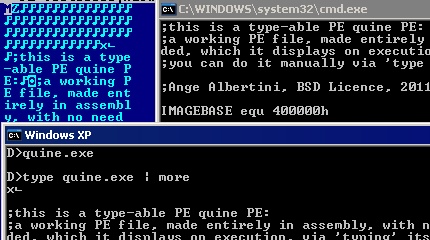
db 'MZ'
align 3bh, db 0dh
dd nt_header - IMAGEBASE
db 0dh
incbin 'quine.asm'
db 1ah
- when executed, quine will open a command window to type itself.
op db "open", 0
fn db "cmd", 0
param db "/K type quine.exe", 0
...
EntryPoint:
push 1
push 0
push param
push fn
push op
push 0
call [ShellExecuteA]tls_aoiOSDET- the address pointed by TLS.AddressOfIndex is cleared on loading.
- if IMAGE_IMPORT_DESCRIPTOR.Name is null, this import descriptor is considered a terminator (imports are no further parsed).
- under XP, it's cleared after imports are parsed, thus the imports are completely loaded.
- under W7, it's cleared before, so the descriptor is considered as a terminator, so imports are no further parsed.
so, depending on the OS that is running, tls_aoiOSDET behaves differently by checking its own imports ...
mov eax, [__imp__MessageBoxA]
cmp eax, hnMessageBoxA - IMAGEBASE
jz W7
...
;user32.dll_DESCRIPTOR:
dd user32.dll_hintnames - IMAGEBASE
dd 0, 0
AddressOfIndex:
dd user32.dll - IMAGEBASE
dd user32.dll_iat - IMAGEBASE
...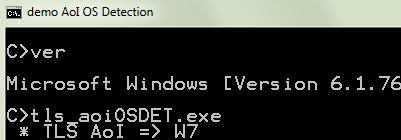 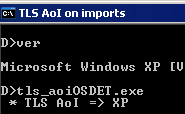
manyimportsW7- this W7-only binary use the TLS AoI trick to clean its imports. On disk, the import table is full of bogus descriptors, which will be ignored on loading
Image_Tls_Directory32:
...
AddressOfIndex dd zero_here_plz
...
zero_here_plz:
%rep 40000h
dd fake_imports - IMAGEBASE + i * 4
... 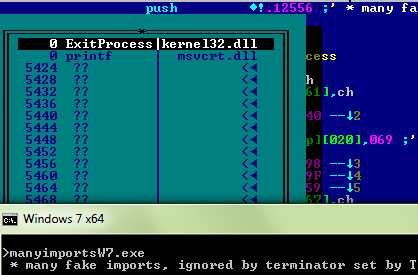
no0code- by using a similar trick as in quine to make a printable DOS header, and relocating the NT HEADERS far enough so that e_lfanew contains no null char, no0code contains no null byte before the code start.
db 'MZ'
align 3bh, db 90h
dd nt_header - IMAGEBASE
db 90h
EntryPoint:
bits 32
...
times 01010000h db ' '
...
nt_header:
istruc IMAGE_NT_HEADERS
at IMAGE_NT_HEADERS.Signature, db 'PE',0,0however, the NT HEADERS magic contains necessarily 2 null bytes, thus it's impossible to have a working PE with no null byte at all. data PEssome specific cases require PE files with less elements than otherwise mentioned Data Filesloading a file via LoadLibraryEx with LOAD_LIBRARY_AS_DATAFILE needs a PE file with only a very few defined elements: not even the Subsystem or the Machine needs to be defined for such a ''library''. - d_tiny.dll is a 61 bytes PE with only 3 defined elements
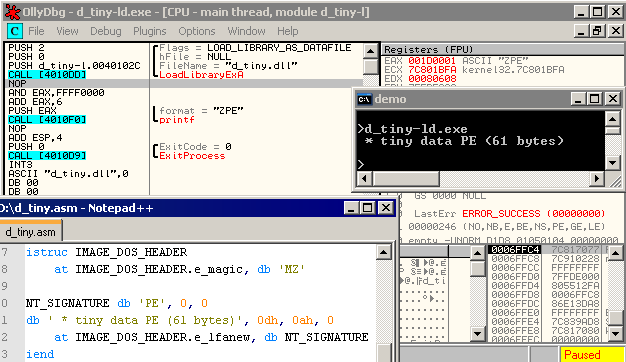
yet even if nothing is defined, its code can still be ran. This allows us to make a non-null PE with code. - d_nonnull.dll is a data PE with executed code and no null character
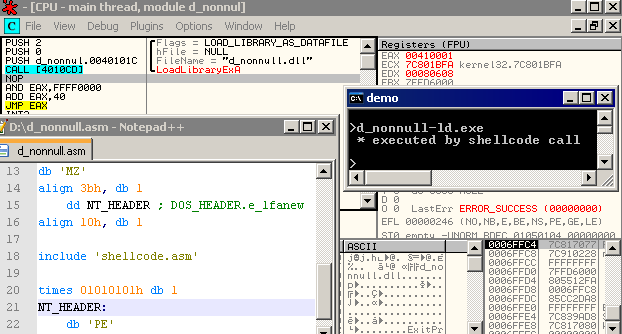
resourcesA standard use for code-less PEs is to store resources. In this case, more fields are required (Machine, SizeOfOptionalHeader, SizeOfHeaders), but most fields can contain bogus values. - d_resource.dll is a PE with a lot of corrupted fields yet correct and usable resources
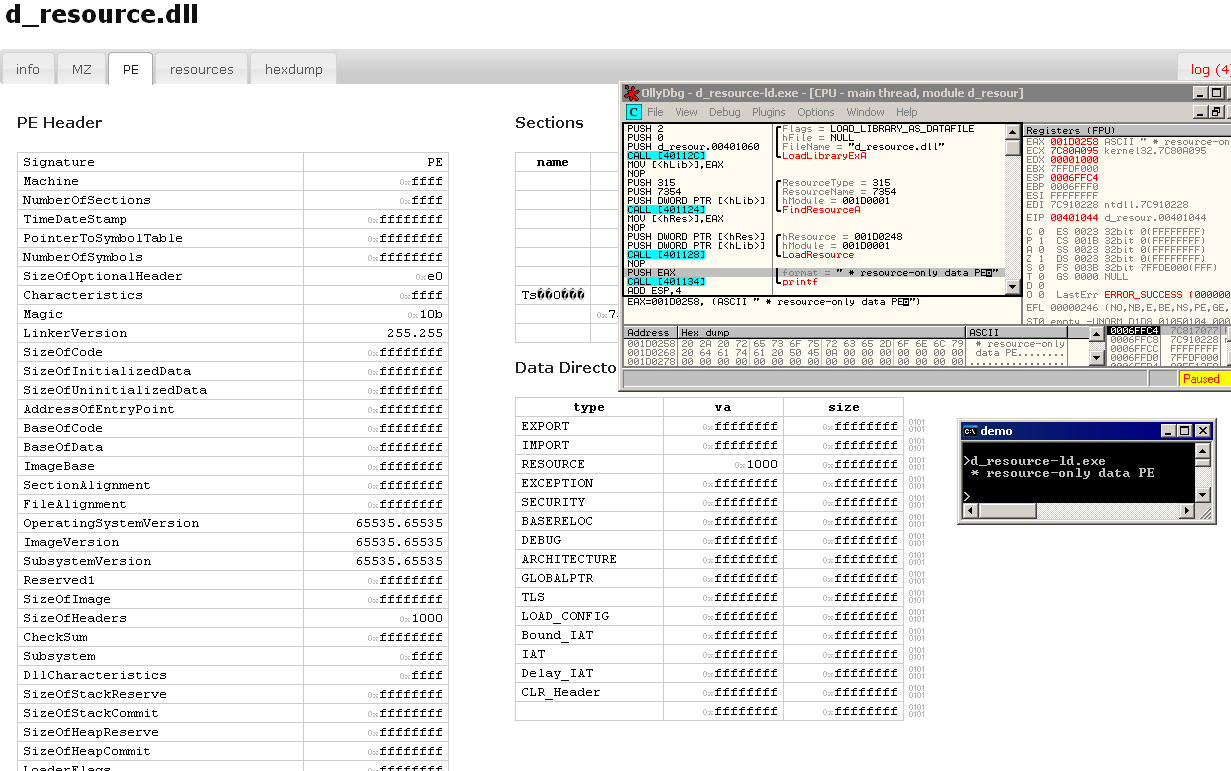
conclusion- a PE executing code can have either no sections, no entrypoint, no data directories - but not at least one of the 3 is required - which breaks the typical model.
- many fields are not relevant, and can have completely bogus values (even important-looking ones such as BaseOfCode, SizeOfCode...)
- many fields are taken into account only once the PE is mapped in memory, which requires a different way of thinking (allocated areas, mapped sections...)
- most fields are not checked for boundaries, even important ones such as EntryPoint, TLS Callbacks, imports, exports...
- several fields enable loader-based decryption (relocations, exports)
- TLS is arguably the most f*cked up part of the PE format.
acknowledgements- Bernhard Treutwein
- Costin Ionescu
- Ivanlef0u
- Kris Kaspersky
- Moritz Kroll
- Walied Assar
extra resources Binary Art - byte-ing the PE that fails you, presented at Hashdays, Luzern, on the 3rd November 2012 external resources<< index Android/Java/x86/... opcodes tables PDF tricks Portable Executable x86 oddities
|

